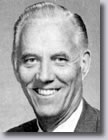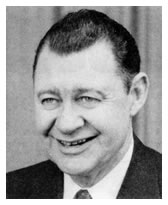First Person | Uncertain Beginning
In 1949, none felt television would soon prove profitable.
 By Wallace J. Jorgenson
By Wallace J. Jorgenson
The Charlotte Observer, June 27, 1982
I remember the day clearly — July 15, 1949. Dignitaries were in abundance. From our home office in Greensboro came Joseph M. Bryan, who had been the driving force behind the purchase of WBT Radio from CBS in 1945. Just before the switch was pulled that would usher in television to this area, legend has it that Mr. Bryan turned to WBT General Manager Charles Crutchfield and said: "Charlie, what if the darn thing doesn't work?
Crutchfield, whose composure normally was rock-like, paled and blurted: "My God, Joe, I never thought of that!"
The story may be aprocryphal, and probably is, but it illustrates the uncertainty of the new venture called television. In retrospect, I'm confident we would not have made the leap into TV at the time had we really assessed the pros and cons. For there was just no way to make a financial go of it — and every indication was that the "black ink" would be a long time coming.
CBS, in fact, had warned us — even before the FCC granted us a television construction permit on February 2, 1948 — that it would be well into the next decade before the coaxial cable would reach Charlotte. This meant we'd have to operate the station with film and old-time kinescopes — pitifully-poor recordings made right off the TV tube. Even Jim Patterson, who signed the station on, did not appear "live." A motion picture film of him was shot and developed earlier in the day.
But folks didn't mind. A full two weeks before sign-on, WBTV ran a test pattern from 12 noon to 7 p.m. daily. People crowded around the central figure of the test pattern — an Indian head — for hours. Occasionally, technical interference would cause the pattern to jiggle, and people would exclaim: "It moved! I saw it move!"
Reception reports were received from cities as far away as 150 air miles. Then, on July 15, more than 12,000 people came to the Charlotte Armory for the first telecast. Others watched on the estimated 1,000 sets in the area. At noon, the American flag appeared accompanied by the National Anthem, and then Jim Patterson's sign-on.
That evening, a motion picture —appropriately titled "A Star Is Born"—was shown. For the next year, the test pattern ran from noon to 6:30 p.m., followed by programs from then to sign-off. Included were Kukla, Fran and 0llie, Arthur Godfrey, Perry Como, Fred Waring and Hopalong Cassidy.
The coaxial cable, once thought to be a decade away from Charlotte, came here in 1950. This was a first view of the speed with which the new technology would rush at us, and it has not abated. In September of 1950, we carried ow first live network program — the UNC-Notre Dame football game. Not even the 14-7 loss to the Irish dimmed that momentous event.
Since then, things have moved a near-cosmic speed, until now — 33 years later — television scans almost every inch of the globe and trains its nebulous eye on the far reaches of outer space. Some of what has happened since the early 1950s now is in soft focus for me, but those early days remain crystal clear.
I wouldn't have missed it for the world.
Wallace Jorgenson is president of Jefferson-Pilot Broadcasting Co., parent company of WBTV.


